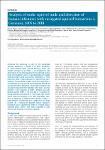Analysis of exotic squirrel trade and detection of human infections with variegated squirrel bornavirus 1, Germany, 2005 to 2018
Tappe, Dennis
Frank, Christina
Homeier-Bachmann, Timo
Wilking, Hendrik
Allendorf, Valerie
Schlottau, Kore
Muñoz-Fontela, César
Rottstegge, Monika
Port, Julia R.
Rissland, Jürgen
Eisermann, Philip
Beer, Martin
Schmidt-Chanasit, Jonas
Following the discovery in 2015 of the variegated squirrel bornavirus 1 (VSBV-1) in fatal encephalitis cases among exotic squirrel breeders and a zoo animal caretaker in Germany, a case definition was developed. It was employed during trace-back animal trade investigations and sero-epidemiological studies among breeders and zoo animal caretakers of holdings with VSBV-1 infected squirrels. During the investigation, two possible human cases who had died of encephalitis were identified retrospectively among the squirrel breeders. Moreover, one probable human case was detected among the breeders who had a positive memory T-cell response to VSBV-1 antigen and antibodies against VSBV-1. The low rate of seropositivity found among living persons in risk groups that handle exotic squirrels privately or at zoos may reflect rareness of exposure to VSBV-1 during animal contact, a high lethality of infection or a combination of these factors. As a precaution against human exposure, testing of exotic squirrels for VSBV-1 infection and/or avoiding direct contact with exotic squirrels in zoos and private holdings is strongly advised.
Dateien zu dieser Publikation

